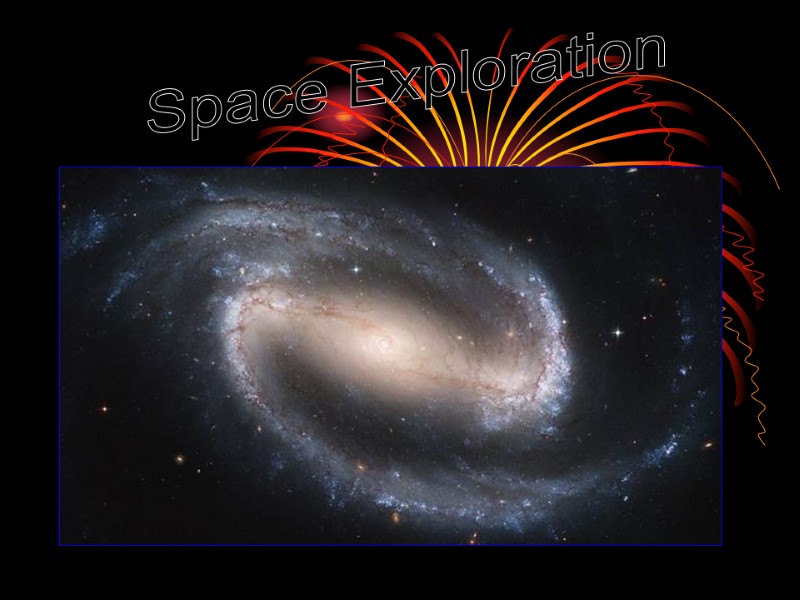 Space Exploration
Space Exploration
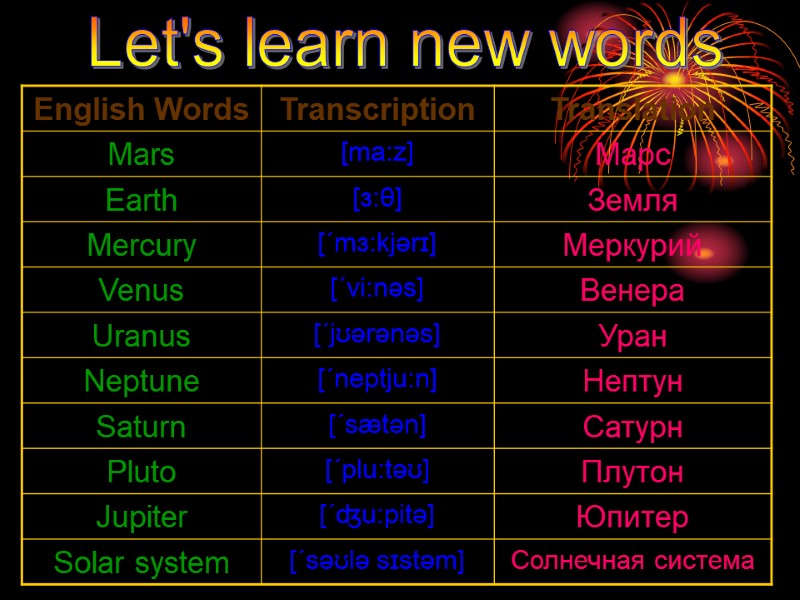 Let's learn new words
Let's learn new words
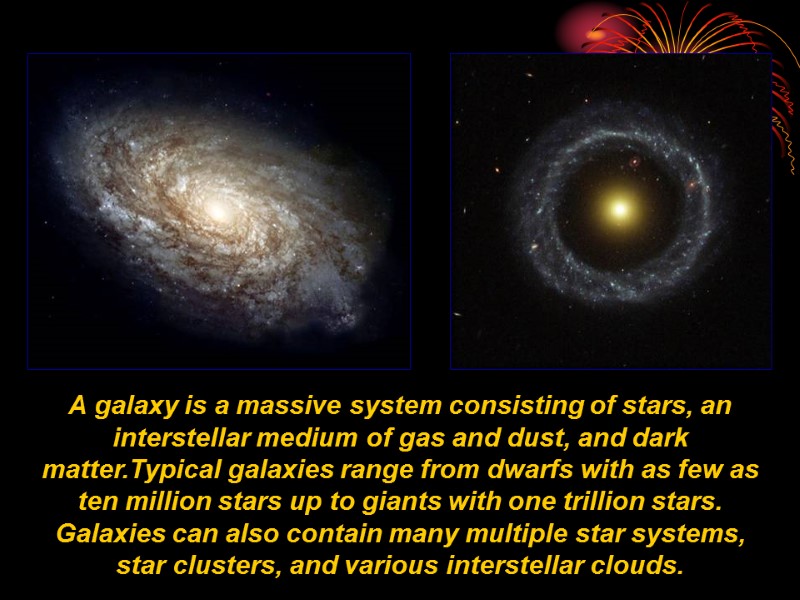 A galaxy is a massive system consisting of stars, an interstellar medium of gas and dust, and dark matter.Typical galaxies range from dwarfs with as few as ten million stars up to giants with one trillion stars. Galaxies can also contain many multiple star systems, star clusters, and various interstellar clouds.
A galaxy is a massive system consisting of stars, an interstellar medium of gas and dust, and dark matter.Typical galaxies range from dwarfs with as few as ten million stars up to giants with one trillion stars. Galaxies can also contain many multiple star systems, star clusters, and various interstellar clouds.
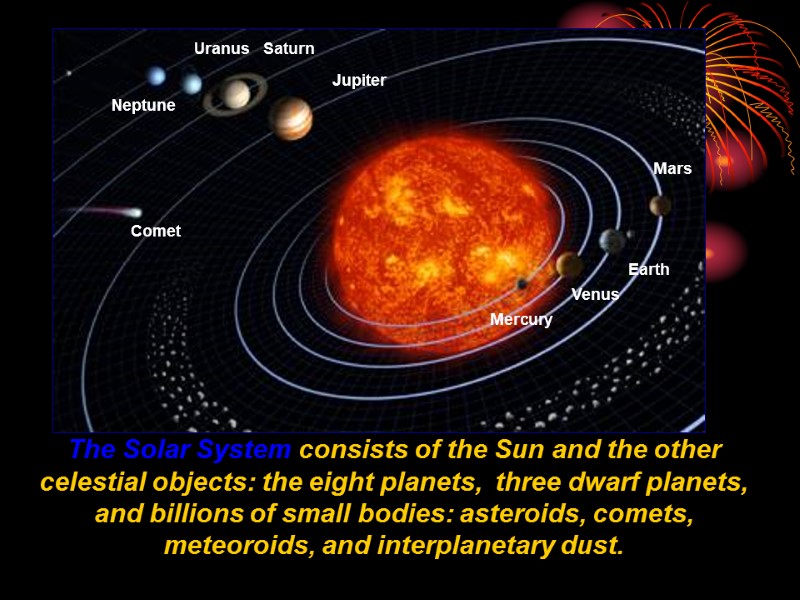 Jupiter Saturn Neptune Mercury Uranus Earth Venus Mars The Solar System consists of the Sun and the other celestial objects: the eight planets, three dwarf planets, and billions of small bodies: asteroids, comets, meteoroids, and interplanetary dust. Comet
Jupiter Saturn Neptune Mercury Uranus Earth Venus Mars The Solar System consists of the Sun and the other celestial objects: the eight planets, three dwarf planets, and billions of small bodies: asteroids, comets, meteoroids, and interplanetary dust. Comet
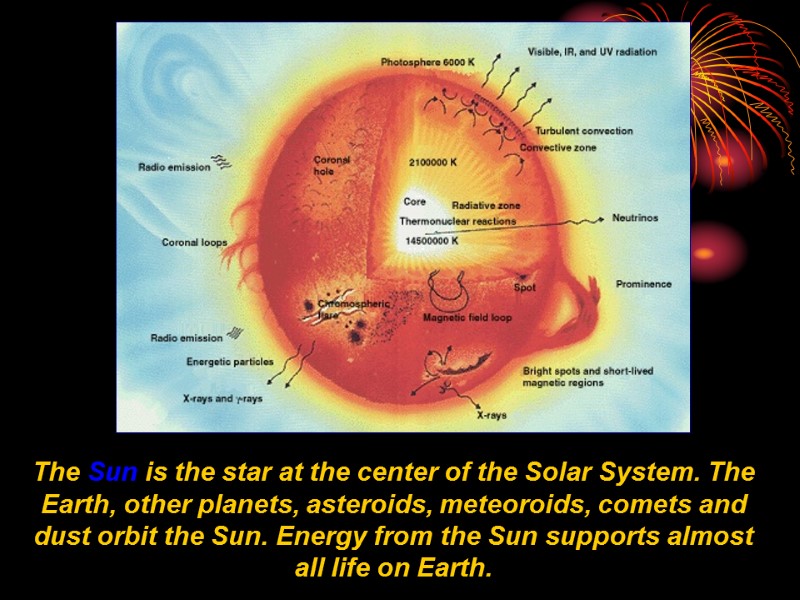 The Sun is the star at the center of the Solar System. The Earth, other planets, asteroids, meteoroids, comets and dust orbit the Sun. Energy from the Sun supports almost all life on Earth.
The Sun is the star at the center of the Solar System. The Earth, other planets, asteroids, meteoroids, comets and dust orbit the Sun. Energy from the Sun supports almost all life on Earth.
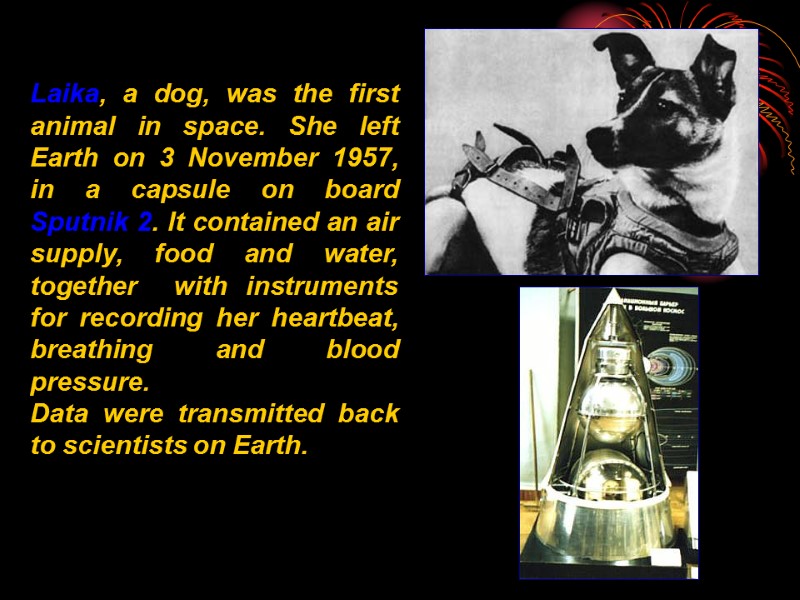 Laika, a dog, was the first animal in space. She left Earth on 3 November 1957, in a capsule on board Sputnik 2. It contained an air supply, food and water, together with instruments for recording her heartbeat, breathing and blood pressure. Data were transmitted back to scientists on Earth.
Laika, a dog, was the first animal in space. She left Earth on 3 November 1957, in a capsule on board Sputnik 2. It contained an air supply, food and water, together with instruments for recording her heartbeat, breathing and blood pressure. Data were transmitted back to scientists on Earth.
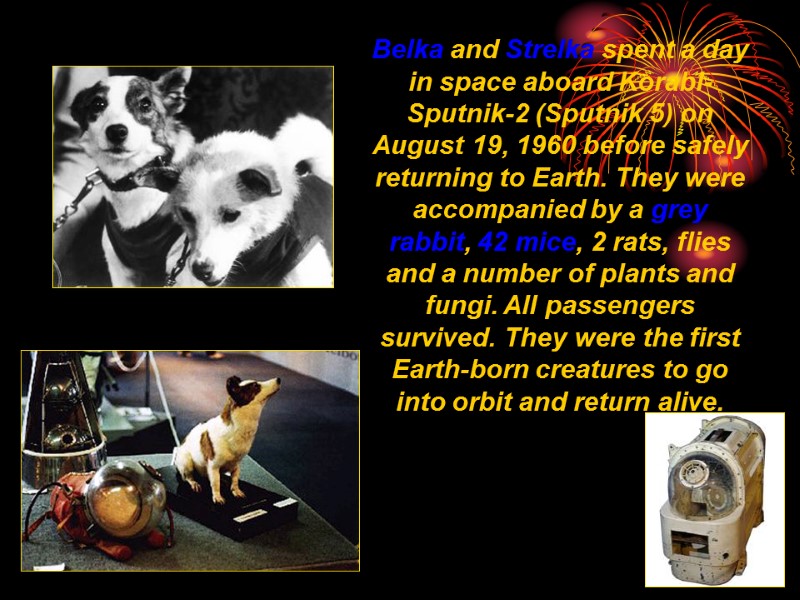 Belka and Strelka spent a day in space aboard Korabl-Sputnik-2 (Sputnik 5) on August 19, 1960 before safely returning to Earth. They were accompanied by a grey rabbit, 42 mice, 2 rats, flies and a number of plants and fungi. All passengers survived. They were the first Earth-born creatures to go into orbit and return alive.
Belka and Strelka spent a day in space aboard Korabl-Sputnik-2 (Sputnik 5) on August 19, 1960 before safely returning to Earth. They were accompanied by a grey rabbit, 42 mice, 2 rats, flies and a number of plants and fungi. All passengers survived. They were the first Earth-born creatures to go into orbit and return alive.
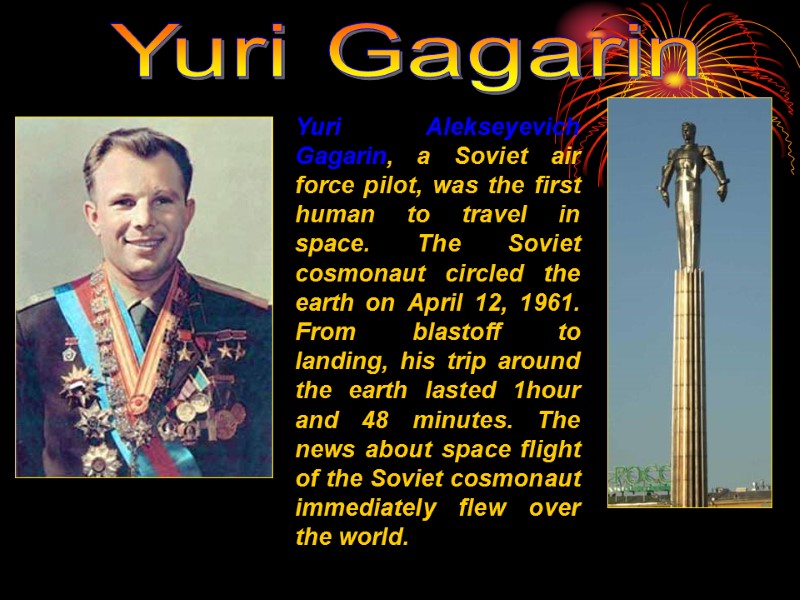 Yuri Alekseyevich Gagarin, a Soviet air force pilot, was the first human to travel in space. The Soviet cosmonaut circled the earth on April 12, 1961. From blastoff to landing, his trip around the earth lasted 1hour and 48 minutes. The news about space flight of the Soviet cosmonaut immediately flew over the world. Yuri Gagarin
Yuri Alekseyevich Gagarin, a Soviet air force pilot, was the first human to travel in space. The Soviet cosmonaut circled the earth on April 12, 1961. From blastoff to landing, his trip around the earth lasted 1hour and 48 minutes. The news about space flight of the Soviet cosmonaut immediately flew over the world. Yuri Gagarin
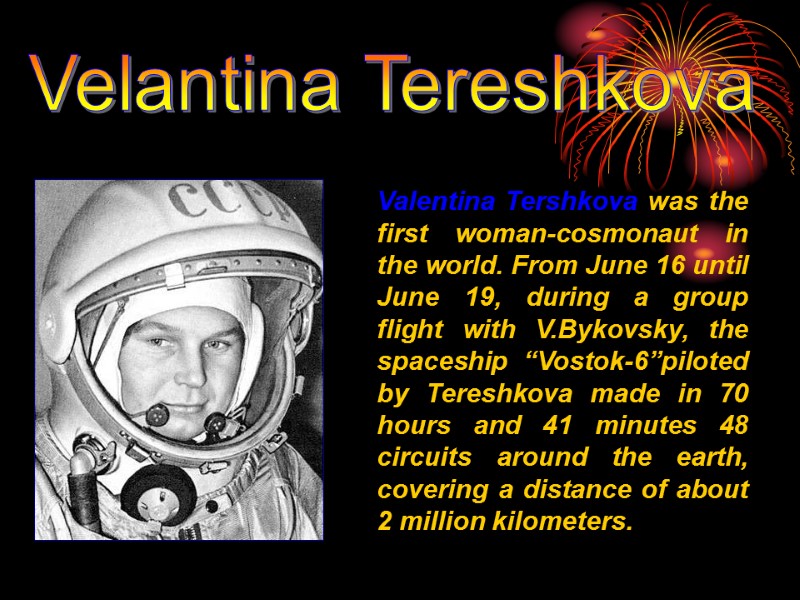 Valentina Tershkova was the first woman-cosmonaut in the world. From June 16 until June 19, during a group flight with V.Bykovsky, the spaceship “Vostok-6”piloted by Tereshkova made in 70 hours and 41 minutes 48 circuits around the earth, covering a distance of about 2 million kilometers. Velantina Tereshkova
Valentina Tershkova was the first woman-cosmonaut in the world. From June 16 until June 19, during a group flight with V.Bykovsky, the spaceship “Vostok-6”piloted by Tereshkova made in 70 hours and 41 minutes 48 circuits around the earth, covering a distance of about 2 million kilometers. Velantina Tereshkova
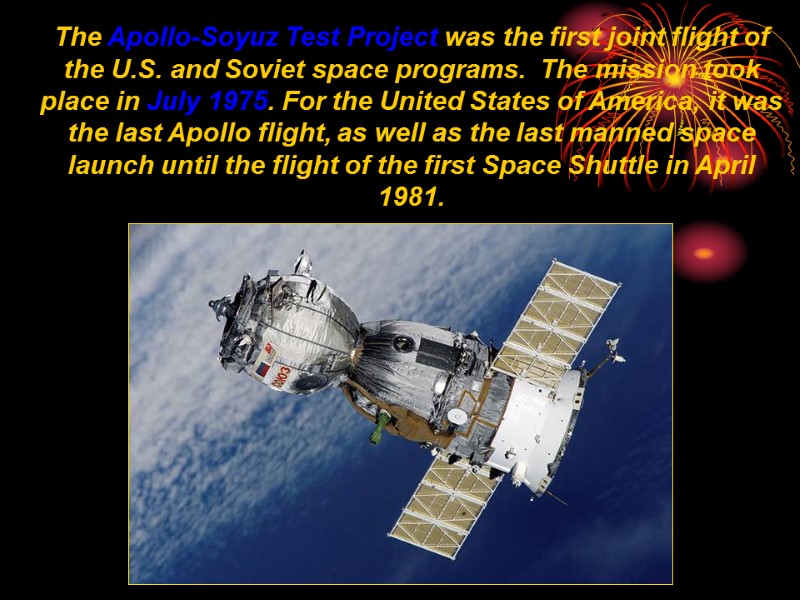 The Apollo-Soyuz Test Project was the first joint flight of the U.S. and Soviet space programs. The mission took place in July 1975. For the United States of America, it was the last Apollo flight, as well as the last manned space launch until the flight of the first Space Shuttle in April 1981.
The Apollo-Soyuz Test Project was the first joint flight of the U.S. and Soviet space programs. The mission took place in July 1975. For the United States of America, it was the last Apollo flight, as well as the last manned space launch until the flight of the first Space Shuttle in April 1981.
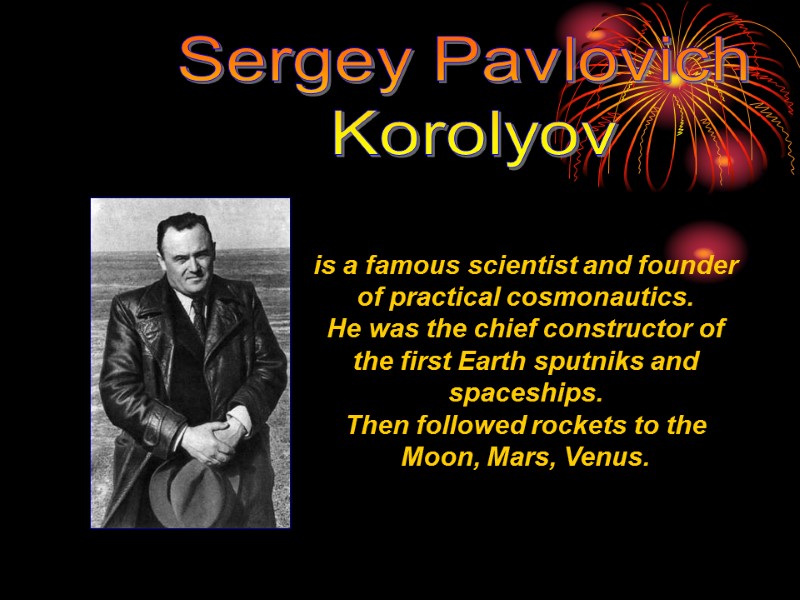 is a famous scientist and founder of practical cosmonautics. He was the chief constructor of the first Earth sputniks and spaceships. Then followed rockets to the Moon, Mars, Venus. Sergey Pavlovich Korolyov
is a famous scientist and founder of practical cosmonautics. He was the chief constructor of the first Earth sputniks and spaceships. Then followed rockets to the Moon, Mars, Venus. Sergey Pavlovich Korolyov
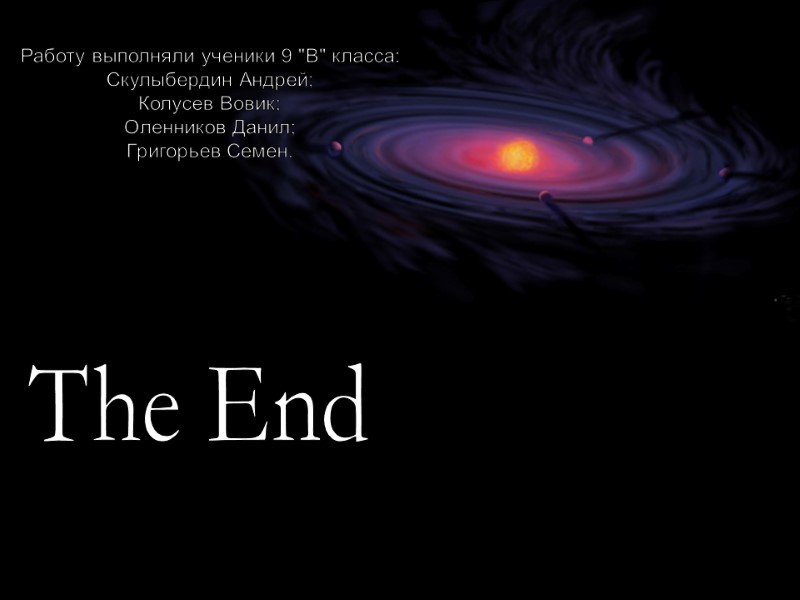 Работу выполняли ученики 9 "В" класса: Скулыбердин Андрей; Колусев Вовик; Оленников Данил; Григорьев Семен. The End
Работу выполняли ученики 9 "В" класса: Скулыбердин Андрей; Колусев Вовик; Оленников Данил; Григорьев Семен. The End























